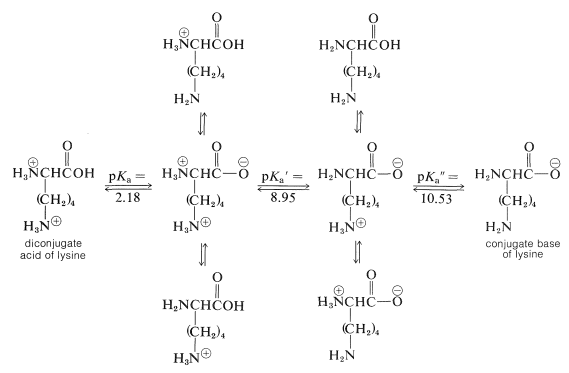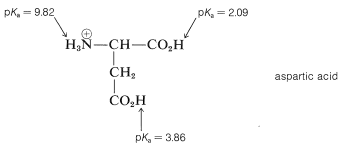25.2: Acid-Base Properties of \(\alpha\)-Amino Acids
- Page ID
- 22358
\( \newcommand{\vecs}[1]{\overset { \scriptstyle \rightharpoonup} {\mathbf{#1}} } \)
\( \newcommand{\vecd}[1]{\overset{-\!-\!\rightharpoonup}{\vphantom{a}\smash {#1}}} \)
\( \newcommand{\id}{\mathrm{id}}\) \( \newcommand{\Span}{\mathrm{span}}\)
( \newcommand{\kernel}{\mathrm{null}\,}\) \( \newcommand{\range}{\mathrm{range}\,}\)
\( \newcommand{\RealPart}{\mathrm{Re}}\) \( \newcommand{\ImaginaryPart}{\mathrm{Im}}\)
\( \newcommand{\Argument}{\mathrm{Arg}}\) \( \newcommand{\norm}[1]{\| #1 \|}\)
\( \newcommand{\inner}[2]{\langle #1, #2 \rangle}\)
\( \newcommand{\Span}{\mathrm{span}}\)
\( \newcommand{\id}{\mathrm{id}}\)
\( \newcommand{\Span}{\mathrm{span}}\)
\( \newcommand{\kernel}{\mathrm{null}\,}\)
\( \newcommand{\range}{\mathrm{range}\,}\)
\( \newcommand{\RealPart}{\mathrm{Re}}\)
\( \newcommand{\ImaginaryPart}{\mathrm{Im}}\)
\( \newcommand{\Argument}{\mathrm{Arg}}\)
\( \newcommand{\norm}[1]{\| #1 \|}\)
\( \newcommand{\inner}[2]{\langle #1, #2 \rangle}\)
\( \newcommand{\Span}{\mathrm{span}}\) \( \newcommand{\AA}{\unicode[.8,0]{x212B}}\)
\( \newcommand{\vectorA}[1]{\vec{#1}} % arrow\)
\( \newcommand{\vectorAt}[1]{\vec{\text{#1}}} % arrow\)
\( \newcommand{\vectorB}[1]{\overset { \scriptstyle \rightharpoonup} {\mathbf{#1}} } \)
\( \newcommand{\vectorC}[1]{\textbf{#1}} \)
\( \newcommand{\vectorD}[1]{\overrightarrow{#1}} \)
\( \newcommand{\vectorDt}[1]{\overrightarrow{\text{#1}}} \)
\( \newcommand{\vectE}[1]{\overset{-\!-\!\rightharpoonup}{\vphantom{a}\smash{\mathbf {#1}}}} \)
\( \newcommand{\vecs}[1]{\overset { \scriptstyle \rightharpoonup} {\mathbf{#1}} } \)
\( \newcommand{\vecd}[1]{\overset{-\!-\!\rightharpoonup}{\vphantom{a}\smash {#1}}} \)
\(\newcommand{\avec}{\mathbf a}\) \(\newcommand{\bvec}{\mathbf b}\) \(\newcommand{\cvec}{\mathbf c}\) \(\newcommand{\dvec}{\mathbf d}\) \(\newcommand{\dtil}{\widetilde{\mathbf d}}\) \(\newcommand{\evec}{\mathbf e}\) \(\newcommand{\fvec}{\mathbf f}\) \(\newcommand{\nvec}{\mathbf n}\) \(\newcommand{\pvec}{\mathbf p}\) \(\newcommand{\qvec}{\mathbf q}\) \(\newcommand{\svec}{\mathbf s}\) \(\newcommand{\tvec}{\mathbf t}\) \(\newcommand{\uvec}{\mathbf u}\) \(\newcommand{\vvec}{\mathbf v}\) \(\newcommand{\wvec}{\mathbf w}\) \(\newcommand{\xvec}{\mathbf x}\) \(\newcommand{\yvec}{\mathbf y}\) \(\newcommand{\zvec}{\mathbf z}\) \(\newcommand{\rvec}{\mathbf r}\) \(\newcommand{\mvec}{\mathbf m}\) \(\newcommand{\zerovec}{\mathbf 0}\) \(\newcommand{\onevec}{\mathbf 1}\) \(\newcommand{\real}{\mathbb R}\) \(\newcommand{\twovec}[2]{\left[\begin{array}{r}#1 \\ #2 \end{array}\right]}\) \(\newcommand{\ctwovec}[2]{\left[\begin{array}{c}#1 \\ #2 \end{array}\right]}\) \(\newcommand{\threevec}[3]{\left[\begin{array}{r}#1 \\ #2 \\ #3 \end{array}\right]}\) \(\newcommand{\cthreevec}[3]{\left[\begin{array}{c}#1 \\ #2 \\ #3 \end{array}\right]}\) \(\newcommand{\fourvec}[4]{\left[\begin{array}{r}#1 \\ #2 \\ #3 \\ #4 \end{array}\right]}\) \(\newcommand{\cfourvec}[4]{\left[\begin{array}{c}#1 \\ #2 \\ #3 \\ #4 \end{array}\right]}\) \(\newcommand{\fivevec}[5]{\left[\begin{array}{r}#1 \\ #2 \\ #3 \\ #4 \\ #5 \\ \end{array}\right]}\) \(\newcommand{\cfivevec}[5]{\left[\begin{array}{c}#1 \\ #2 \\ #3 \\ #4 \\ #5 \\ \end{array}\right]}\) \(\newcommand{\mattwo}[4]{\left[\begin{array}{rr}#1 \amp #2 \\ #3 \amp #4 \\ \end{array}\right]}\) \(\newcommand{\laspan}[1]{\text{Span}\{#1\}}\) \(\newcommand{\bcal}{\cal B}\) \(\newcommand{\ccal}{\cal C}\) \(\newcommand{\scal}{\cal S}\) \(\newcommand{\wcal}{\cal W}\) \(\newcommand{\ecal}{\cal E}\) \(\newcommand{\coords}[2]{\left\{#1\right\}_{#2}}\) \(\newcommand{\gray}[1]{\color{gray}{#1}}\) \(\newcommand{\lgray}[1]{\color{lightgray}{#1}}\) \(\newcommand{\rank}{\operatorname{rank}}\) \(\newcommand{\row}{\text{Row}}\) \(\newcommand{\col}{\text{Col}}\) \(\renewcommand{\row}{\text{Row}}\) \(\newcommand{\nul}{\text{Nul}}\) \(\newcommand{\var}{\text{Var}}\) \(\newcommand{\corr}{\text{corr}}\) \(\newcommand{\len}[1]{\left|#1\right|}\) \(\newcommand{\bbar}{\overline{\bvec}}\) \(\newcommand{\bhat}{\widehat{\bvec}}\) \(\newcommand{\bperp}{\bvec^\perp}\) \(\newcommand{\xhat}{\widehat{\xvec}}\) \(\newcommand{\vhat}{\widehat{\vvec}}\) \(\newcommand{\uhat}{\widehat{\uvec}}\) \(\newcommand{\what}{\widehat{\wvec}}\) \(\newcommand{\Sighat}{\widehat{\Sigma}}\) \(\newcommand{\lt}{<}\) \(\newcommand{\gt}{>}\) \(\newcommand{\amp}{&}\) \(\definecolor{fillinmathshade}{gray}{0.9}\)The behavior of glycine is reasonably typical of that of the simplest amino acids. Because glycine is neither a strong acid nor a strong base, we shall expect a solution of glycine in water to contain four species in rapid equilibrium. The proportions of these species are expected to change with pH, the cationic conjugate acid being the predominant form at low pH and the anionic conjugate base being favored at high pH:

Spectroscopic measurements show that the equilibrium between neutral glycine and the dipolar ion favors the dipolar ion by at least 100 to 1. This is to be expected because the \(\ce{H_3} \overset{\oplus}{\ce{N}}-\) group of the dipolar ion will stabilize the \(\ce{-CO_2^-}\) end while the \(\ce{-CO_2^-}\) group will stabilize the \(\ce{H_3} \overset{\oplus}{\ce{N}}-\) end.
The acid-ionization constant of \(\ce{H_3} \overset{\oplus}{\ce{N}} \ce{CH_2CO_2H}\) is \(4.5 \times 10^{-3}\) (p\(K_a\) \(= 2.34\), Equation 25-1), which is about 25 times greater than \(K_a\) for ethanoic acid (Section 18-2). This is expected because of the electron-attracting electrostatic effect of the \(\ce{H_3} \overset{\oplus}{\ce{N}}-\) group. Ionization of the \(\ce{H_3} \overset{\oplus}{\ce{N}}-\) group of the dipolar ion (\(K_a = 2.0 \times 10^{-10}\); p\(K_a = 9.60\); Equation 25-2) is oppositely affected by the electrostatic effect of the \(\ce{-CO_2^-}\) group and is 10 times less than of ethanammonium ion (Section 23-7B). The manner in which the concentrations of the charged glycine species change with pH is shown in Figure 25-1. Notice that, between pH 3 and pH 8, almost all of the glycine is in the form of the dipolar ion. The pH at the center of this range, where the concentration of \(\ce{H_3} \overset{\oplus}{\ce{N}} \ce{CH_2CO_2H}\) is equal to the concentration of \(\ce{H_2NCH_2CO_2^-}\), is called the isoelectric point, pI, and usually corresponds to the pH at which the amino acid has minimum water solubility. Isoelectric points for the amino acids are shown in Table 25-1. The isoelectric points are the average of the p\(K_a\) values for dissociation of the monocation and the dipolar ion forms of the amino acid. For glycine, pI \(= \left( 2.34 + 9.60 \right) /2\).

\[\text{p} K_a = \text{pH} + \text{log}_{10} \frac{\left[ \ce{H_3} \overset{\oplus}{\ce{N}} \ce{CH_2CO_2H} \right]}{\left[ \ce{H_3} \overset{\oplus}{\ce{N}} \ce{CH_2CO_2^-} \right]} = 2.34 \tag{25-1}\]
\[\text{p} K'_a = \text{pH} + \text{log}_{10} \frac{\left[ \ce{H_3} \overset{\oplus}{\ce{N}} \ce{CH_2CO_2^-} \right]}{\left[ \ce{H_3NCH_2CO_2^-} \right]} = 9.60 \tag{25-2}\]
The pH behavior of amino acids with either acidic or basic functional groups attached to the side chains is more complicated than of simple amino acids. For example, there are three acid dissociations starting with the diconjugate acid of lysine:

The p\(K_a\) values for the side-chain functions of acidic and basic amino acids are given in Table 25-1.
We already mentioned how the \(\ce{H_3} \overset{\oplus}{\ce{N}}-\) group of the conjugate acid of glycine enhances the acid strength of the carboxyl group compared to ethanoic acid and how the \(\ce{-CO_2^-}\) group reduces the acidity of the \(\ce{H_3} \overset{\oplus}{\ce{N}}-\) group of the dipolar ion relative to ethanammonium ion. These effects will be smaller the farther away the charged group is from the ionizable group. As a result, one would predict that the carboxyl groups of aspartic acid would have different p\(K_a\) values, and indeed this is so:

Similarly, the side-chain ammonium group of lysine is less acidic than that of the ammonium group close to the carboxyl group:

Contributors and Attributions
John D. Robert and Marjorie C. Caserio (1977) Basic Principles of Organic Chemistry, second edition. W. A. Benjamin, Inc. , Menlo Park, CA. ISBN 0-8053-8329-8. This content is copyrighted under the following conditions, "You are granted permission for individual, educational, research and non-commercial reproduction, distribution, display and performance of this work in any format."


